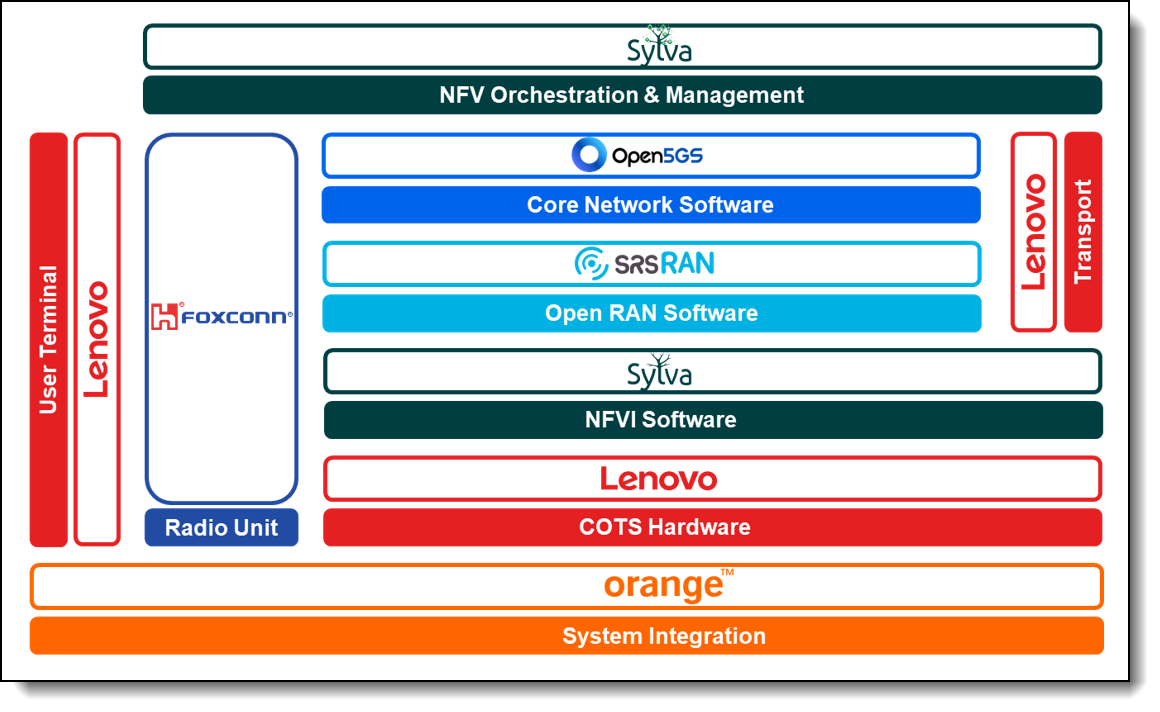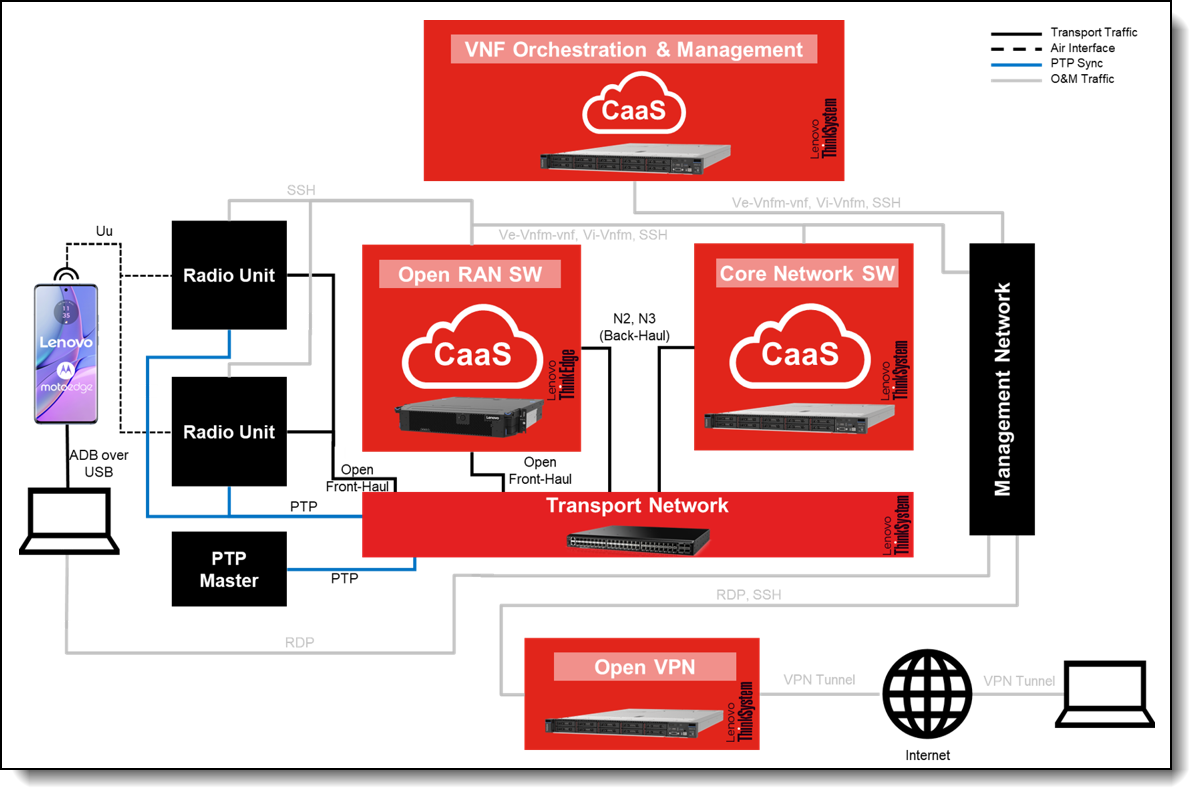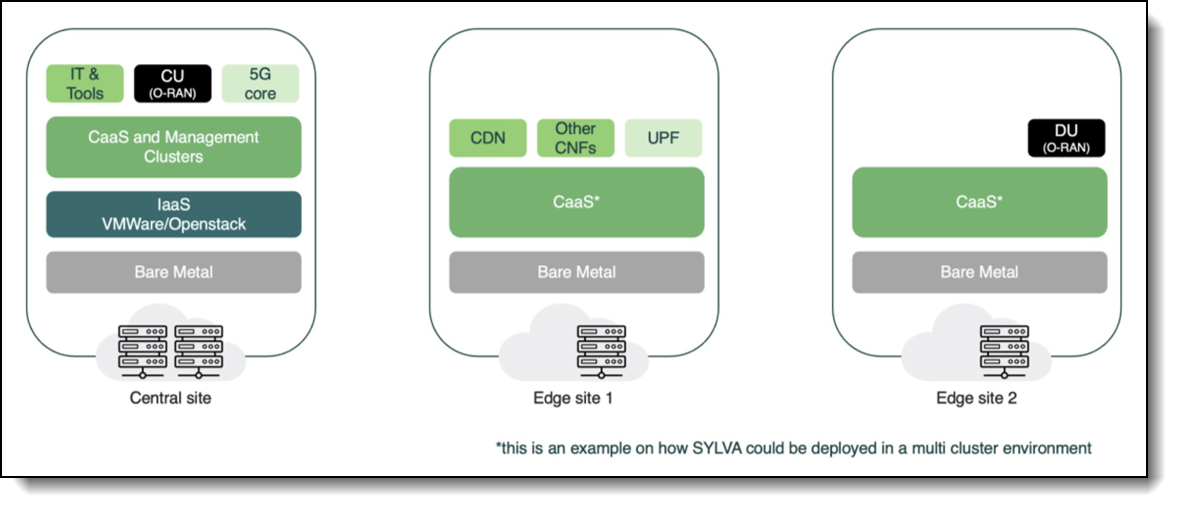Author
Published
24 Jan 2024Form Number
LP1883PDF size
8 pages, 590 KBAbstract
In this paper, we describe how Lenovo demonstrated End-to-End (E2E) deployment orchestration in a disaggregated multi-vendor 5G stand-alone environment at the Open RAN PlugFest event in November 2023. The solution used Motorola Edge, ThinkEdge and ThinkSystem offerings to provide User Equipment (UE), Open RAN DU & CU, and 3GPP 5G Core (5GC) network services. The event was hosted by Orange as continuation of the Lenovo/Orange Joint Innovation Program.
Introduction
Open RAN (Radio Access Network) is a disaggregated, software-based and programable version of radio access technologies driven by Communication Service Providers themselves to meet the needs of future communication systems. Open RAN proposes more intelligent, highly automated, disaggregated and fully interoperable mobile networks, ensuring a diverse supply chain [1]. It is already being addressed as an option for greenfield deployments, identified as a further accelerator for brownfield deployments over the next 2 years and is a key enabler for Private Network Deployments.
Open RAN is promising, but it also has several challenges. Lifecycle/configuration management and multi-vendor interoperability are presently two of the major concerns of Open RAN. Deployment automation and orchestration are critical to eliminate these risks and perform successful Open RAN deployments which shall be further supported by a continuous testing process. This is a complex and continuous activity requiring the validation of thousands of artifacts as part of installation, configuration, integration and testing of each new service or E2E stack release.
O-RAN Alliance is the Standards Development Organization (SDO) for Open RAN technology aiming to ease the efforts in multi-vendor environments via Open RAN PlugFest events. PlugFest events provide feedback on the standardization process for solving the potential issues. Those are organized by hosts, providing access to lab facilities, with the support of O-RAN Alliance to address the most common complexities of Open RAN. Participation from vendors, system integrators & institutions enable all parties to work in a highly collaborative environment.
Lenovo is committed to supporting disaggregation in Telco and open, flexible, multi-vendor enabled technology stacks helping service providers to achieve greater operational agility while lowering Total Cost of Ownership (TCO). Lenovo supports Open RAN and similar projects; one example is Project Sylva [2].
Lenovo and Orange are working on a Joint Innovation Program to advance research on new technologies including energy consumption and power utilization monitoring. Recently, Orange and Lenovo joined their forces as part of this program [3] in a fully disaggregated lab setup, orchestrating the E2E 5G SA network powered by Open RAN technology.
References:
[1] Innovating Together: OpenRAN Project Group Progress and Future Horizons, Telecom Infra Project, October 2023 https://telecominfraproject.com/
[2] Operators Telco Cloud – White Paper, Sylva Project, 2022 https://sylvaproject.org/
[3] Global PlugFest Fall 2023 Initiated with 100 Participating Companies and Institutions, O-RAN Alliance, November 2023 https://www.o-ran.org/
Purpose of Study
Lenovo and Orange collaborated to verify deployment of a fully disaggregated 5G System (5GS) in the Orange Open Testing and Integration Center (OTIC) Lab in Rennes. Several vendors participated in ensuring the interoperability of a multi-vendor environment. Furthermore, deployment orchestration of Open RAN workloads on Lenovo’s Commercial off-the-shelf (COTS) hardware was scoped in this Project.
This activity is a significant milestone for continuous integration, deployment and testing processes of telco workloads throughout their lifecycle. It accelerates the capability enablement and reduces Time-to-Market (TTM) of new features in Telco networks. Open-source technologies were used in this study to demonstrate the power of openness and flexibility of the ecosystem in the new era of disaggregation.
Scope of Work
Lenovo and Software Radio Systems (SRS) come together with Orange to setup an E2E 5GS network powered by Open RAN in Rennes Lab as part of PlugFest scope. The target was to integrate RAN and further 5GC cloud native workloads into the Network Function Virtualization (NFV) Orchestration layer to automate the entire network with a single click.
Key components of the solution:
- Orange assumes the role as prime system integrator managing the physical installation, networking and E2E integration of RAN, Core Network (CN) and attached user terminals to the network.
- User terminals and the infrastructure layer are provided by Lenovo
- Radio Units are from Foxconn
- Open RAN software, CU/DU was provided by SRS (see https://www.srsran.com/5g)
- Additional technologies are integrated using open source solutions:
- Project Sylva Kubernetes
- RKE2 for container runtime
- Open5GS for CN
- Project Sylva for NF Orchestration and Management
- Transport layer among RAN, CN and Orchestration layers are provided by Lenovo being integrated to a Precise Time Protocol (PTP) master.
A layered partner, technology view of the project scope is shown in Figure 1.

Figure 1. Layered Deployment Blueprint
In the setup, Open Front-Haul (OFH) is integrated between Foxconn, RPQN 7801 and srsRAN Project Distribution Unit (DU) via 7.2 split. The system is configured to serve 2x2 Multiple-Input Multiple-Output (MIMO) channels utilizing a 50 MHz bandwidth at 3.7GHz for end-user communication. The Central Unit (CU) is as well provided by srsRAN pre-integrated to DU and it is further integrated to Open5GS over 3GPP’s N2/N3 references interfaces. On top, Orange integrated Linux Foundation’s Sylva Project into the RAN Container Network Function (CNF) deployment orchestration. All these are powered on Lenovo’s ThinkEdge and ThinkSystem portfolio providing E2E connectivity for real user terminals. Devices are Lenovo’s MotoEdge products performing downlink (DL) and uplink (UL) test cases in line with O-RAN Testing and Integration Focus Group’s (TIFG) E2E test specifications. Further details about deployment architecture overview are given in Figure 2.

Figure 2. Deployment and Integration Architecture
As seen in Figure 2, RAN functions are deployed with the ThinkEdge portfolio where CN, Management Plane and IT functions are deployed in ThinkSystem portfolio:
- ThinkEdge server and client devices are hyperconverged solutions that simplify IT infrastructure and accelerate time to value, freeing teams to focus on core business and new capabilities. It is designed and built with the unique requirements for edge computing for Telco in mind, and it is versatile enough to stretch the limitations of server locations, providing a variety of connectivity and security options and easily managed via Lenovo XClarity Controller or Redfish.
- ThinkSystem servers are sustainable computing platforms offering unmatched value, flexibility, and industry-leading efficiency to meet enterprise workloads’ mission-critical demands with legendary quality and reliability. deliver high value with a small, organized footprint. These servers are easily expandable and scalable, while able to handle most data center workloads at telco grade reliability, 99,999%.
- MotoEdge phones push the boundaries of what a smartphone can do with ultra-fast connectivity speeds, exceptional cameras, brilliant displays and embedded Artificial Intelligence (AI) capabilities.
This project is an important milestone for Sylva, as it is integrated for the first time into RAN CNF deployment orchestration. Project Sylva has achieved significant milestones since its launch in November 2022, publishing the public version of the stack and establishing a validation center. Sylva addresses use cases as 5GC Distributed User Plane Functions (UPF), Content Delivery Network (CDN) or Open RAN providing an architecture that is able to manage central to far edge sites, Figure 3.

Figure 3. Project Sylva Reference Deployment Options (Source: sylvaproject.org)
Both Orange and Lenovo are active contributors to Sylva Project to unify the cloud and orchestration layer that will support reducing operational costs for Telco operators.
Teams from Lenovo, Orange and srsRAN collaborated actively during the project. Orange provided extended remote accessibility to lab environment on the management plane which ensured installation, integration and troubleshooting activities in an agile manner without need of any lab visit by any vendor.
Future Work
E2E Deployment Orchestration is a critical milestone for automated deployment scenarios in Telco for both accelerating rollouts and enabling new use cases for edge computing. Additionally, to fully harness the potential of open technologies in cellular networks, several supplementary tasks are outlined below:
- Deployment and operation of multiple RAN workloads on a single edge server
- Enablement of massive Multi-Input Multi-Output (MIMO) scenarios
- Sustainability measures of 5GS deployments in the lab and at network scale
- Energy optimization with RAN Intelligent Controller (RIC) and cloud elasticity
- Zero Touch Provisioning (ZTP) of all network layers
- Continuous Integration / Continuous Deployment / Continuous Testing integration in the lab and further integrity to orchestration layer
- Performance, interoperability testing of Open RAN
- Dynamic E2E network slicing provisioning and enablement on the fly
- Edge, Private use-cases enablement on Open RAN powered 5GS networks
Conclusion
Telco and IT companies have been converging for more than a decade with the help of IP based systems, cloudification and more. While CN workloads, especially 5GC, are already running on cloud over COTS hardware; RAN is the final and largest piece of this convergence being driven by Open RAN technology. As higher throughput, lower latency and exponentially growing device connectivity is expected with 5G, operators plan to deploy significantly more RAN sites and workloads (compared to previous xGs) in their networks which brings greater momentum for Open RAN technology enablement unifying the infrastructure layer to benefit from a diverse supply chain, multi-purpose computation power and workload/network scale elasticity.
Both Lenovo and Orange are committed to help Open RAN technology to evolve towards commercially deployable solutions; being either for greenfield or brownfield, and whatever the deployment scenario is (macro, micro-private networks, etc.). This study proved the interoperation of truly disaggregated 5GS network fully automated using a MANO compliant open-source orchestrator to exploit the real potential. Both parties are further committed to support disaggregation in Telco for any generation, beyond 5G and ready to participate in the upcoming PlugFest events.
Author
Sinan Atan is a seasoned leader in AI and Advanced Infrastructure Solutions at Lenovo. With over 14 years of international experience, he has established himself as a Digital Transformation expert, specializing in consulting, engagement, and the delivery of cutting-edge technologies through complex, multi-year programs. His career spans a wide range of domains and technologies, providing him with a comprehensive, end-to-end expertise in digitalization and AI technologies. Sinan holds both BSc and MSc degrees in Telecommunications and was previously a PhD candidate in the same field. Before joining Lenovo, he held leadership roles at Ericsson and Accenture, where he contributed to innovative solutions and strategic growth.
Trademarks
Lenovo and the Lenovo logo are trademarks or registered trademarks of Lenovo in the United States, other countries, or both. A current list of Lenovo trademarks is available on the Web at https://www.lenovo.com/us/en/legal/copytrade/.
The following terms are trademarks of Lenovo in the United States, other countries, or both:
Lenovo®
ThinkEdge®
ThinkSystem®
XClarity®
The following terms are trademarks of other companies:
Linux® is the trademark of Linus Torvalds in the U.S. and other countries.
Other company, product, or service names may be trademarks or service marks of others.
Configure and Buy
Full Change History
Course Detail
Employees Only Content
The content in this document with a is only visible to employees who are logged in. Logon using your Lenovo ITcode and password via Lenovo single-signon (SSO).
The author of the document has determined that this content is classified as Lenovo Internal and should not be normally be made available to people who are not employees or contractors. This includes partners, customers, and competitors. The reasons may vary and you should reach out to the authors of the document for clarification, if needed. Be cautious about sharing this content with others as it may contain sensitive information.
Any visitor to the Lenovo Press web site who is not logged on will not be able to see this employee-only content. This content is excluded from search engine indexes and will not appear in any search results.
For all users, including logged-in employees, this employee-only content does not appear in the PDF version of this document.
This functionality is cookie based. The web site will normally remember your login state between browser sessions, however, if you clear cookies at the end of a session or work in an Incognito/Private browser window, then you will need to log in each time.
If you have any questions about this feature of the Lenovo Press web, please email David Watts at dwatts@lenovo.com.
